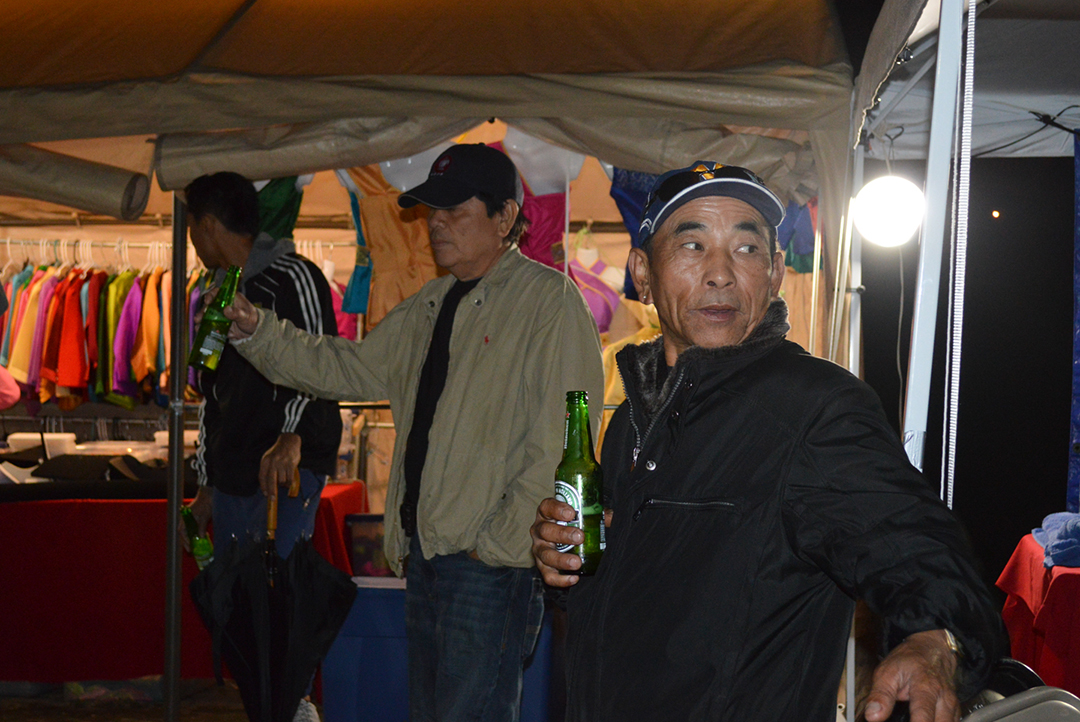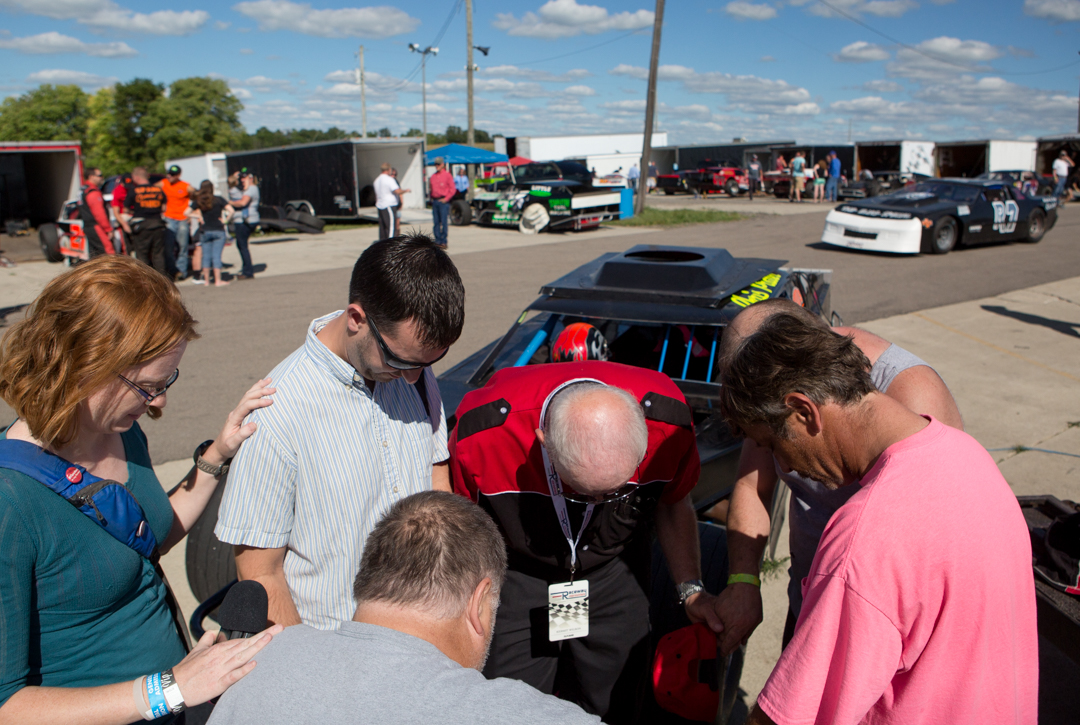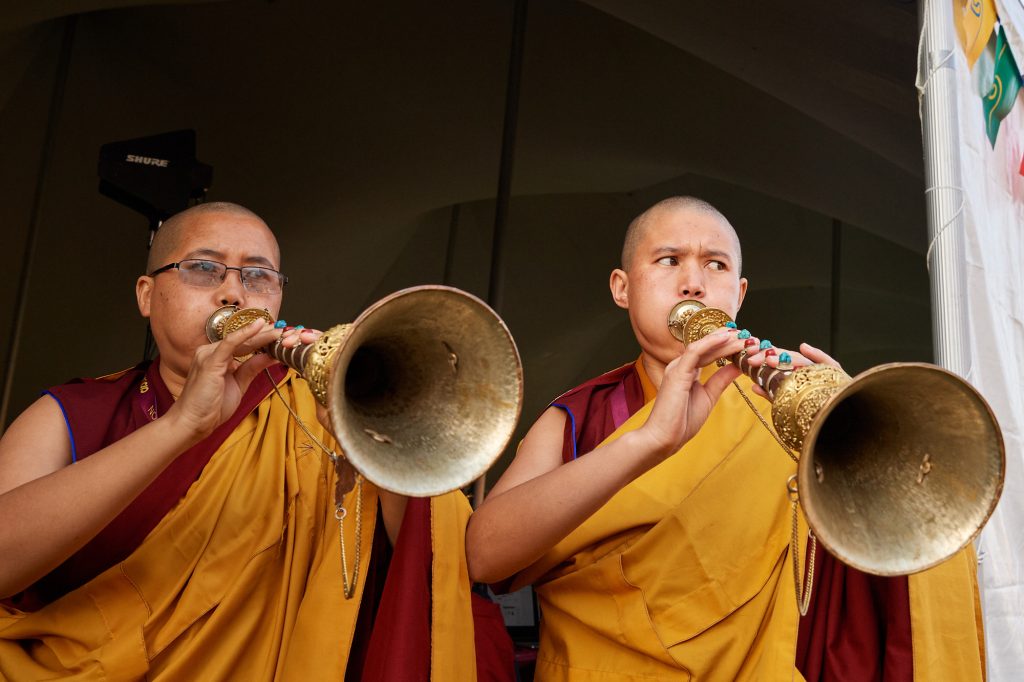Three years ago in May, scholar Isaac Weiner stood inside Wat Buddha Samakidham, a Theravada Buddhist temple in Columbus, Ohio, as its members celebrated Vesak, the holiday commemorating the birth and life of the Buddha. Resident monks and women who had taken monastic bhikkhuni vows for the weekend participated in formal meditation and chanting sessions, while outside, locals gathered for the Southeast Asian festival, where vendors were selling food and merchandise.
Walking around the area as night fell, Weiner began recording the chanting sessions and noises outside. As the festival closed down, men and women who had worked the kiosks all evening chatted and drank beer. The sounds of the monks chanting still echoed faintly in the distance amidst the noises of traffic and the crowd.
“I think it’s a really interesting moment, the kind of overlap of the mundane and the extraordinary, the religious festival and the cultural festival, the commercial and the spiritual,” recalled Weiner, an associate professor of comparative studies at Ohio State University.
That recording was later uploaded to the American Religious Sounds Project, a digital platform and database of religious audio that launched on Wednesday, May 15. The platform, developed by scholars, students, and multimedia staff, provides an intimate look into the vast sonic landscape of religion and focuses in particular on how secular and religious sounds may unexpectedly intersect.
“I think sound is something that goes between public and private spaces . . . across religious communities and raises larger questions for Americans about who we are and where we think religion belongs,” Weiner said.

Co-developed with Amy DeRogatis, a professor of religion and American culture at Michigan State University, and a team of students and staff researchers, the project integrates audio, text, and images centered around the theme of religious sound and space, and how community interactions and partnerships may shape those sounds.
Related: A Diversity of Voices
At the time of its launch, the site featured about 100 audio clips recorded over the past four years, including 11 recordings from local Buddhists. Most clips are between 30 seconds to 3 minutes in length. The site is divided into two sections: a mapping database where users can search for short recorded clips with specific tags (religious tradition, language, type of space, institution, type of sound [silence, laugher, chanting, singing], time [year or day]) as well as a “gallery” with more curated audio-clip collections organized by theme.
Focusing on sound, Weiner and DeRogatis argue, offered a medium to explore questions about religious diversity through the embodied experience of listening, and challenged students to practice listening and conversation skills in an increasingly hypervisual world.
“I was really excited about finding new ways to think about some basic questions in the study of religion with my students, both introductory and advanced, about lived religion. Religion as it’s practiced,” DeRogatis said. “And particularly I was interested in getting an opportunity to think about what we were studying in the classroom by going out into our local community.”
Although many of the recordings evoke particular contexts, places and moments, such as a community pilgrimage to an Islamic center in East Lansing, Michigan, or a Lenten fish fry dinner at a Serbian Orthodox church, many other recorded moments reflect on the intersection of both religious and secular sounds: the voice of a chaplain leading a prayer at a race track in small Ohio town as cars roar in the background; the mingling of voices at interfaith events and political rallies.
“Often we think about religion as something transcendent and special. And that is an aspect of religion. But so much of religion too is the mundane, everyday sociality of it,” Weiner said.
Some recordings also document specific transformations and dramatic events within communities. A recording at an interfaith peace circle in support of the Columbus Karma Thegsum Chöling (KTC) center in Ohio was recorded after its building burned down in an act of arson. Team members recorded moments with the KTC at its old space and followed them as they moved to a new building.
“One of the things that appealed to us about sound was the relationship between sound and space,” Weiner said. “So here we have a community that ends up for various reasons practicing in different spaces and contexts, and we were doing recordings in different spaces and thinking about how religion happens in these different kinds of contexts.”
Silence emerged as an important theme in recorded moments with Buddhists (such as in one clip where practitioners participate in a silent meditation punctuated by the sound of bells), but also in the academic comparison of silent religious practices. Silence might appear during both religious and secular moments (“a moment of silence,” for instance), and more broadly speaking, the concept of silence can spark discussions on inclusion and about why certain religious groups may be more or less visible in American society.
Related: Buddhism’s Postmodern Age
“[There’s] a lot of work happening in digital humanities about silence in the archive and how you read it . . . just because something isn’t there, doesn’t mean it doesn’t exist, or just because you can’t hear it doesn’t mean it isn’t there,” DeRogatis said.
The team hopes to add about ten new recordings every two weeks so that eventually between 300 and 400 recordings are uploaded. The project, which initially received funding from the Humanities Without Walls consortium, received additional funding from the nonprofit Henry Luce Foundation to document more sounds in Missouri, Wisconsin, and Georgia. In the future, the project may also expand with traveling exhibits where communities can make their own recordings.
DeRogatis and Weiner note that central questions that began the project—What does religion in the United States sound like? Where should you go to hear it? How might we understand religious diversity differently if we listen for it?—keep providing new ways to explore religious diversity as the project grows.
“No matter how long we’ve been at this and how many recordings we’ve been doing, we keep coming back to these questions of how we label religious sound,” DeRogatis said. “We’re not really coming to any answer with it. We’re just finding new ways to think about what religious sounds are. That central question continues to really animate what we do and it continues to be a really important and interesting question.”
The Professors’ Picks
Isaac Weiner and Amy DeRogatis have selected their favorite clips from the American Religious Sounds Project. Below is the audio with the professors’ explanations.

Isaac Weiner: We spent a Sunday afternoon at Shadybowl Speedway, a racetrack in Ohio, and walked around with Kermit Wilson, the racetrack chaplain. The clip brings together moments from throughout our day together.
Throughout our conversation, you can hear the constant roar of race cars in the background, and you can almost feel the vibration. Chaplain Wilson talks about why the racetrack is his church and why ministers there rather than in a traditional church, and you can hear the cars the whole time. So you hear him talk about the space while the soundscape evokes it. And you get a sense of movement. The cars are moving as we’re physically walking around and recording. So we, the recordists, are moving in much the same way that religious communities and their members move. All of that—the space, the conversation, and the movement—comes together nicely in this recording, so it captures a lot of the project.
Amy DeRogatis: In my class at Michigan State University we talked about moments where food, religion, and sound intersect. I had been bringing students to the Sikh Gurdwara in Lansing, Michigan, and one day we decided to record the langar, which is the communal meal served after the worship service.
We asked a community member to talk about why Sikhs always provide meals in between or after the services. The recording is about a minute from a longer interview that was conducted in the worship space after the service. I really love the recording because you can hear the ambient sounds of other people conversing and coming in and out of the worship space as they go downstairs to join the Langar. As the community member explains why he thinks the Langar is central to the practice of being a Sikh, listeners get a vivid sense of being in that space in between the formal service and before the communal meal.
Edited for clarity
Thank you for subscribing to Tricycle! As a nonprofit, we depend on readers like you to keep Buddhist teachings and practices widely available.
